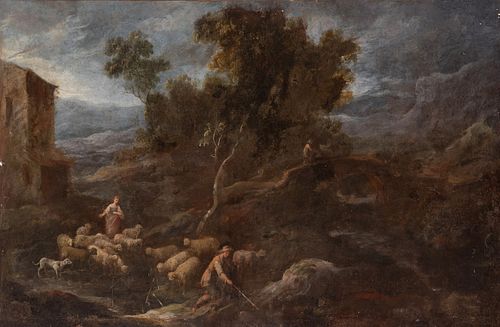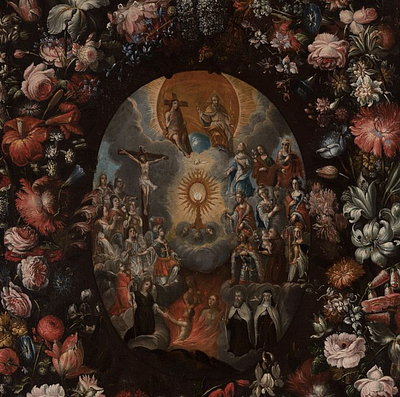Andalusian School; late seventeenth century. "Pastoral scene". Oil on canvas. Re-colored.
Lot 43
About Seller
Setdart Auction House
Carrer Aragó 346
Barcelona
Spain
Setdart Subastas was born in 2004 and is currently the first online art auction in Spain with solidity, prestige and reliability guaranteed by our more than 60,000 users. Setdart has a young, dynamic and enterprising team ready to successfully manage the purchase and sale of art works through custom...Read more
Estimate:
EUR€1,500 - EUR€2,000
$1,612.90 - $2,150.54
Absentee vs Live bid
Two ways to bid:
- Leave a max absentee bid and the platform will bid on your behalf up to your maximum bid during the live auction.
- Bid live during the auction and your bids will be submitted real-time to the auctioneer.
Bid Increments
| Price | Bid Increment |
|---|---|
| EUR€0 | EUR€10 |
| EUR€200 | EUR€25 |
| EUR€500 | EUR€50 |
| EUR€1,000 | EUR€100 |
| EUR€3,000 | EUR€200 |
| EUR€5,000 | EUR€500 |
| EUR€10,000 | EUR€1,000 |
| EUR€20,000 | EUR€2,000 |
| EUR€50,000 | EUR€5,000 |
About Auction
By Setdart Auction House
Jul 14, 2021
Set Reminder
2021-07-14 06:30:00
2021-07-14 06:30:00
America/New_York
Bidsquare
Bidsquare : OLD MASTERS
https://www.bidsquare.com/auctions/setdart-auction-house/old-masters-7202
Setdart Auction House sofia@setdart.com
Setdart Auction House sofia@setdart.com
- Lot Description
Andalusian School; late seventeenth century. "Pastoral scene". Oil on canvas. Re-colored. Presents repainting and patches. Size: 114 x 172 cm. This painting presents similarities with the work of the artists Ignacio de Iriarte (Azcoitia, 1621 - Seville, 1670), and Matías de Arteaga y Alfaro (Villanueva de los Infantes, Ciudad Real, 1633 - Seville, 1703), who was attached to the Sevillian school, knew how to collect and interpret with his own personality the double influence of Murillo and Valdés Leal. Son of the engraver Bartolomé Arteaga, while still a child his family moved to Seville, where he would be trained in his father's workshop and in contact with Murillo, whose influence reveals his early work together with that of Valdés Leal, who settled in Seville the same year that Arteaga passed the master painter's exam, in 1656. In 1660 he was among the founding members of the famous drawing academy promoted by Murillo, among others, of which he served as secretary between that date and the year 1673. Oil on canvas of horizontal format, in which an image of country or pastoral character is developed. In the foreground, the author places a group of characters accompanied by several animals. The characters represented in the scene are a man and a woman who by their gestures and disposition are working. The latter is enjoying a nap. Due to the important presence of the landscape and the small dimensions of the characters, the author's special interest in capturing the landscape is evident. It is worth mentioning that this was a time in which the feeling began to beat that human and nature should be complementary, one reflected in the other. That is to say, the landscape should arouse emotion and transmit ideas. Thus, landscape painters like the author of this painting tried to express their feelings through the landscape, instead of imitating it. This idea was established through two main aspects: the dramatic, of turbulent and fantastic views, and the naturalistic, which emphasized images of a peaceful and serene nature, as in this case. It is this second conception that we see embodied in this work; the painter tries to communicate a religious reverence for the landscape, nature in its fullness, free from the industrial elements of modern life. In fact, the painter's use of light here conveys a dreamy atmosphere that invites the viewer to meditate and contemplate himself in the landscape. The landscape is nevertheless made up of manifestations of very different types and not comparable to each other; it does not affect all national schools equally, remaining more faithful to the tradition in schools such as the Italian, French or Dutch. Thus, in this canvas we do not find the grandiose scenery of the British and Germans, the rugged mountains. On the contrary, it is a landscape centered on the foreground.
- Shipping Info
-
In-house shipping available. Please inquire at admin@setdart.com.
-
- Buyer's Premium



 EUR
EUR CAD
CAD AUD
AUD GBP
GBP MXN
MXN HKD
HKD CNY
CNY MYR
MYR SEK
SEK SGD
SGD CHF
CHF THB
THB













